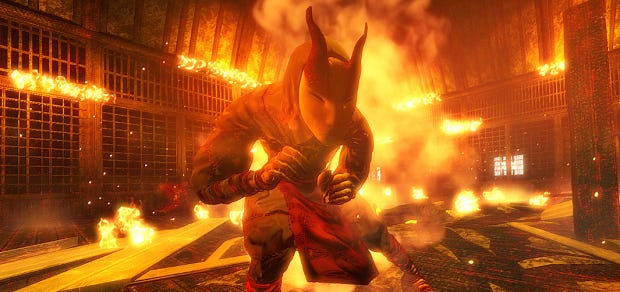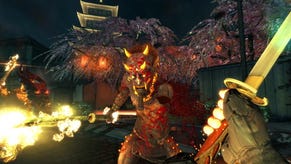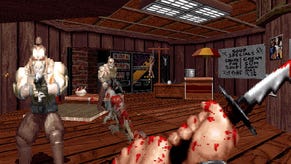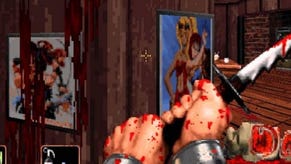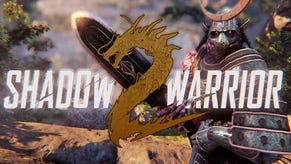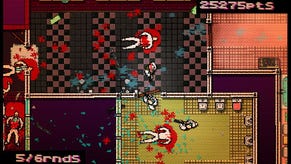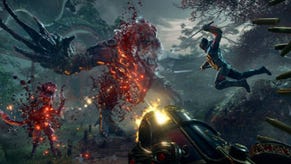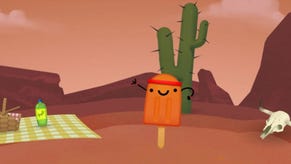Wot I Think: Shadow Warrior
Sturm und Wang
This was unexpected. I was willing to believe that bringing Lo Wang back was a good idea but far from sure of it. Two days of carnage later, I’m convinced. The biggest problem with the Shadow Warrior reboot is that it isn’t a Blood reboot because if Caleb ever does return to our screens, he’s probably not going to do it in this much style. Here’s wot I think.
Flesh slides apart, splitting at the lines traced by Lo Wang’s katana. Limbs pirouette through the air like distressed ballerinas, Black Swan’s painting oozing red slugs of viscera in the air. Heads topple from shoulders and the last demon, its remaining hand held up in surrender, limps and cringes, surrounded by the remnants of its allies. Shadow Warrior is excessively gory and I find its brand of ultraviolence fantastically entertaining.
It’s the bloodiest game I’ve played for a good while, but even on the rare occasions that enemies are human rather than demonic, the dismemberment has a slapstick quality. It’s a claret-covered Looney Tunes cartoon, in the style of Evil Dead 2 or Jackson’s Braindead. That’s a mark that many modern games miss, or refuse to aim at, and it’s the first reassurance that this is a reboot that understands the appeal of its predecessor. I also think it's a better Serious Sam game than Serious Sam 3, despite never reaching the scale of the series and despite the fact that I liked Serious Sam 3.
Here are a few of the things about Shadow Warrior that work well and conjure up memories of the glorious nineties.
Killing bad guys is fun! In the nineties, we were usually supposed to kill the things in computer games without thinking about it too much and without regretting it at all. I forget that because these days, even when I’m playing games about atrocious hell-monsters, moral dilemmas occasionally hit me in the face and the reward for my gleeful clicking is images of horrific suffering. When I chop a monster into messes, I don’t want its grieving widow to billow into view, holding out a tear-stained invitation to the closed casket funeral.
That sort of thing has its place but I’m incredibly pleased that Shadow Warrior unashamedly revels in carnage, rarely feeling the need to explain or to question. Mostly, the plot speeds along like a deranged buddy movie (Wang’s buddy is a camp demon that has attached itself to him), with only the occasional detour into mythology that threatens to suck the energy out of proceedings. I don't care about the backstory or sad memory-golems because when I am being told about these things I am not dancing through the armies of darkness, a death-dealing dervish with a sharp-steeled circumference.
Secrets! Yes, number two on the list of things that Shadow Warrior does (mostly) well are secret areas. They usually contain one of the three upgrade resources and the best ones will have a retro reference or two. I found the subway station from the original Shadow Warrior’s opening level behind a wall, which I naturally blew up by shooting a barrel. Not a modern recreation of it but the original thing, with giant pixelated walls and a train texture that is almost identical to a wall texture. There are also sprites hidden in the game – dead characters, in their old-fashioned form, ripped straight from the Build engine.
I thought I was the best at finding secrets. It’s a forgotten skill in this sort of game and I figured I was one of the few who still had it. Smugly collecting hidden stashes of money and karma, I was always dismayed and impressed that I’d found an average of three out of eleven or so on each level. It’s a game worth exploring a second time. My hint? Shoot everything. Do that anyway, the first time. There’s a reason you have so many bullets.
There’s a negative side to the secrets and it ties into the upgrade system. I don’t like missing secrets because it means I’m missing out on upgrades and quite often, finding a hidden cache simply means walking in the wrong direction. Given two corridors, one will lead to the next stage and the other will lead to a dead-end with a prize hidden in it. There are smarter examples but I did feel like efficiency was being punished at times.
Swords! This ties back to ‘killing bad guys is fun’. Killing them with guns and crossbows is fine, but killing them with a sword is better. Any sort of weapon will make them fall to pieces but it’s good to see that process up close and personal. The shotgun is handy on that count as well, being effective over a range of about a metre as shotguns should be, but it comes relatively late in the game.
Swordfighting isn’t complicated. At first, I was irritated by the lack of a parry or block button, but I quickly realised I was thinking wrong. Shadow Warrior is like a racing game that really doesn’t need a button for the brakes. There are, initially, two types of attack, a charged chop that splits enemies down the middle and the standard slashes, which build into simple combos.
Later, there are upgrades, many of which add new katana abilities. I wanted all of the upgrades and even enjoyed the beautiful menu screens for each of the three types. They either show gun models, painted scrolls or Wang’s tattooed body (but not wang). Guns require cash and the other two are filled in using one of two types of spiritual currency. Each has several mini skill trees associated with it and there are a wide range of powers available, either passive or activated using a double push in a certain direction and a click of one of the mouse buttons. Forward, forward, LMB charges the katana for a powered forward thrust, for example, and sideways twice followed by LMB performs a whirling attack, striking in every direction. The latter is particularly brilliant. There is little more pleasurable than running into a group of demons, shrugging off their blows, guns holstered, and decapitating six or seven simultaneously.
Explosions! Is there a car, motorbike, barrel or crate of fireworks nearby? You’ll definitely want to shoot at it. Often, a single well-placed bullet will cause a chain reaction of destruction and chaos, ripping an entire street or room to pieces and leaving every once-living thing charred and ruined. If anything stumbles from the wreckage, pop a bullet between its eyes or prepare to slice and dice. A variety of killings in any given area provides a greater karma reward. That is how karma works. Yes.
Characters and humour! Oh, wait, this is the bad bit, but thankfully it’s nowhere near as bad as it could have been. Lo Wang is still called Lo Wang, which says a lot about the sort of funny bone the jokes are aimed at. A few of the more unfortunate Fortune Cookies aside, there’s little to raise either eyebrows or smiles. I appreciated some of the posters hanging around the world, with their sly allusions, but I laughed more at the violence than the dialogue.
In fairness, I grew to like Lo Wang by the third chapter or so. He’s a hired killer, sure, but there’s a slightly naïve and sympathetic quality to him, even when he’s dripping with entrails. Aside from the demon companion - a lightweight Darkness with a whinging voice that doesn’t come close to Mike Patton’s possessed performance - there are few other spoken parts and I’d prefer the game with less story altogether. Go here, kill that, pick up a new sword, kill something bigger. That’s all it needs.
Environments! There’s less variety than I would have liked but I like the look of the world. It’s mostly a series of arenas, connected by tight corridors of bamboo or graves, but there’s a consistency to the design, part cartoon, part reality. The strength of the layouts is that they allow for large amounts of enemies in tight spaces, encouraging swordplay but rewarding varied combat techniques. Larger monstrosities drag Lo Wang toward them even as he fends off their minions, and switching to a shotgun and blowing their arms off during the approach doesn’t stop being amusing, even after twelve hours.
The Build engine games - particularly Duke Nukem 3D, Blood and Shadow Warrior - occupied more of my teenage time than id’s first-person slaugherfests, despite hours upon hours spent with Quake and Doom. The three games mentioned were full of borrowed catchphrases, and playful takes on pop culture and genre movies, but despite the spoofing and mockery, they were also creating levels that resembled reality. The opening levels of all three took place somewhere that I recognised, at least vaguely: a cinema, a train station and a funeral home (I was a morbid youngster).
That familiarity was a huge part of their charm, as was the interactivity of the environments. Granted, ‘interactivity’ mostly meant you could have a wee, flush a toilet and blow everything up, but it was gratifying to leaving a mark on the world. A step toward convincing the player that the avatar had solidity and presence, even if that presence was directed toward violence and destruction.
The new Shadow Warrior, thankfully, demonstrates a fine understanding of these things. Its environments are sensible, if simple, and most of the objects scattered across them explode, shatter or burn. It’s a game about inflicting harm on everything on the screen and by concentrating on that experience, without the distraction of puzzles or platforming, Flying Hog have captured a great deal of what was special about early first-person shooters.
There are complexities to master, particularly in the karma reward system, but combat doesn’t change a great deal throughout. Monsters that can resurrect the dead need to be targeted before the rest and flying enemies require a few sharp shots, but Shadow Warrior is the same game at the end as it was at the beginning. For me, playing over a couple of days, it did become repetitive, but only toward the end of the story. I’d rather that than forced puzzle sections, added to extend the length and add the spectre of variety, or more of the boss fights that are the most tedious encounters.
Completely against my expectations, I can’t think of a first-person shooter I’ve enjoyed more this year. Owing as much of a debt to Serious Sam as to the game that it takes its name from, Shadow Warrior rarely pauses for breath. In fact, it rarely changes pace at all. Wang’s movement seemed erratic to me at first, too fast and slippery, but I soon realised that I had it all wrong. Other games are too slow. When there are this many demons to kill and so many ways to kill them, it’s better to move fast and to carry a big sword. Job done.
Shadow Warrior is available today.
